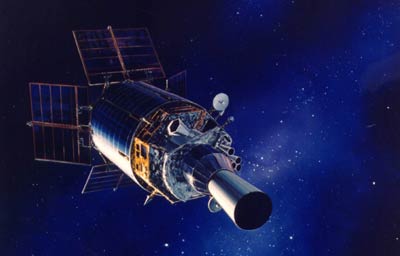Space technology and the next DCIby Taylor Dinerman
|
| Not even the best spy satellite can get inside the mind of a terrorist or a dictator. Neither the Keyholes nor the Lacrosses can see through a roof or into a cave. |
A very rough guess is that the US spends about $15 billion a year on space-based intelligence gathering. This includes the classic optical intelligence satellites, such as the KH-12 series; radar satellites, commonly referred to as the Lacrosse series, owned and operated by the National Reconnaissance Office, under what is now called the National Geospatial-Intelligence Agency (NGA); signal intelligence and electronic intelligence satellites controlled by the NSA and DIA; and the space-based communications networks that feed the data from these satellites to the analysts and users on Earth. The replacement cost of this array is probably in the $100 to $200 billion range. The value of the trained personnel involved in running this system is incalculable.
So the question arises, is all this worth it? The limitations of space-based intelligence are well known. Not even the best spy satellite can get inside the mind of a terrorist or a dictator. Neither the Keyholes nor the Lacrosses can see through a roof or into a cave. More seriously, they failed to give the US firm and timely information on Saddam’s WMD program. This is the most serious shortcoming, and one that the next DCI will have to spend a lot of time thinking through.
Why did our hyperspectral and other highly advanced measurement and signature intelligence (Masint) effort fail to accurately identify and detect the WMD in Iraq and elsewhere? There are rumors that these systems did, in fact, see what looked like convoys carrying WMD materials from Iraq to Syria in the weeks before the US invasion last year. So far, however, these are still just rumors. We can build spectrometers that can detect the chemical composition of a planet’s atmosphere hundreds of light years away, so why can we not accurately determine the existence of nerve gas stockpiles from three or four hundred miles up?
There has been a lot of talk about the need to reform America’s whole intelligence organization. In his book Fixing Intelligence, General Bill Odom, former head of the NSA, has proposed a complete revamping of the system along sensibly functional lines. Yet, the whole “craft of intelligence,” as Alan Dulles called it is, in fact, a “uniquely human endeavor.” This is especially true for the analysis and interpretation aspects. The great virtue of technical intelligence is that it reduces, if not eliminates, all of the biases, both large and small, that inevitably creep into the estimates. A decoded message may or may not be true, but the spectral signature of a tank is much harder to fake.
Conventional wisdom in Washington seems to accept the idea that the US has depended too much on technology and not enough on people to gather the secret intelligence without which any nation cannot operate in the modern world. It might be worthwhile to take a careful look at this assumption. What if the problem was a dysfunctional technology development effort? What if the sensors on today’s NRO spacecraft were inferior to those that the scientists at NASA are about to put into orbit around Saturn? What if only a very few analysts at the CIA were scientifically literate enough to determine if the IR signature from a given factory indicated that it was no longer making pesticides and was now making nerve gas? What if the problem with the intelligence community was not enough technology rather than too much?
| For decades, NRO’s own spacecraft did the “real” work. Today, an imagery analyst can use products from American, European, Israeli, Indian, Russian, or Japanese satellites. |
Our enemies have a pretty good idea of the capabilities of our spy satellites and they must keep track of when they are overhead. This ability to hide when they know that they are being observed limits, but does not eliminate, the usefulness of these systems. The Clinton-era Future Intelligence Architecture program was intended to somewhat remedy this by building and launching enough satellites so that no place on earth would be safe from persistent space-based observation. The program is seriously behind schedule and has suffered reported cost overruns of more than 100%. Recent reports indicate that this program is now back on track or at least out of the intensive care ward.
To compensate somewhat, the Bush administration has been purchasing remote sensing imagery from commercial sources, including DigitalGlobe and Space Imaging. For the NGA and the rest of the intelligence community, this has been a painful revolution. For decades, they were used to having exclusive control over the operations of America’s spy satellites, civilian satellites, such as Landsat, and the French Spot may occasionally have provided useful additional imagery, but NRO’s own spacecraft did the “real” work. Today, an imagery analyst can use products from American, European, Israeli, Indian, Russian, or Japanese satellites.
While the quality and quantity of imagery available to the US intelligence community may be constantly improving, the next DCI should take a long hard look at the ways the data are interpreted. There are all too few highly trained and experienced personnel, but that has always been a problem. What may be more important is a lack of investment in new technology that can transform the digital pixels into reliable information that consistently defeats the deception efforts of America’s adversaries.
